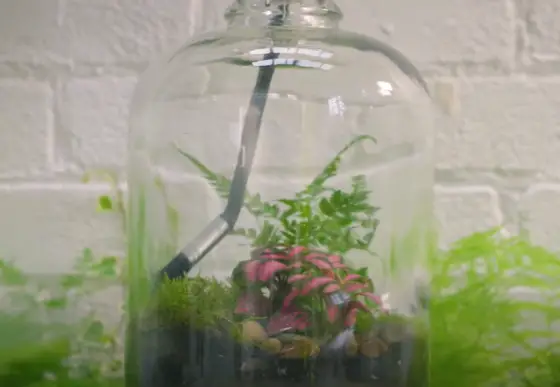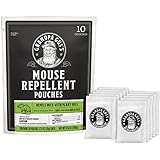Looking to add a touch of green to your indoor space? Creating a terrarium with air plants could be the perfect solution. Not only do these unique plants require minimal maintenance, but they also add a fresh and vibrant element to any room. Wondering how to make a terrarium with air plants?
Look no further! In this article, we’ll guide you through the simple steps to create your own mini botanical masterpiece. Get ready to bring the beauty of nature indoors and create an enchanting display that will leave your friends and family in awe.
Let’s dive right in!
How to Make a Terrarium with Air Plants
Do you want to bring a touch of nature into your home or office? Creating a terrarium with air plants is a fantastic way to do just that.
Not only are terrariums visually appealing, but they also require minimal maintenance, making them perfect for people with busy lifestyles or those who struggle to keep traditional plants alive.
In this blog post, we will guide you through the process of making your own terrarium, complete with air plants, and provide you with helpful tips and tricks along the way.
What is a Terrarium?
Before we dive into the specifics of making a terrarium with air plants, let’s first understand what a terrarium is. A terrarium is a miniature garden enclosed in a glass container, typically made of glass or plastic.
Its purpose is to create a self-sustaining ecosystem where plants can thrive with minimal intervention.
Why Choose Air Plants for Your Terrarium?
Air plants, also known as Tillandsias, make an excellent choice for terrariums for several reasons. Here are some of the benefits of using air plants:
- Low maintenance:
Air plants are incredibly easy to care for. Unlike traditional plants that require soil and regular watering, air plants absorb moisture and nutrients through their leaves, making them low maintenance and hassle-free.
- Unique appearance:
Air plants come in various shapes, sizes, and colors, adding a unique and eye-catching element to your terrarium.
- Versatility:
Air plants can be placed in various containers, including glass orbs, hanging terrariums, or open containers. Their versatility allows you to get creative and design a terrarium that matches your personal style.
- Improved air quality:
Like other plants, air plants help improve indoor air quality by filtering pollutants and releasing oxygen.
Read More: About Do Prayer Plants Like Sun?
Materials Needed
Now that we understand the basics, let’s gather the materials you’ll need to create your own terrarium with air plants:
- Glass container:
Choose a glass container that suits your style and desired terrarium size. It can be a fishbowl, a glass jar, or a geometric terrarium.
- Air plants:
Purchase air plants from a reputable supplier. Look for healthy plants with vibrant colors.
- Decorative elements:
Consider adding decorative elements such as rocks, pebbles, colored sand, moss, or seashells to enhance the visual appeal of your terrarium.
- Moss or lichen:
These can be used as a natural filler around the air plants, providing an additional layer of moisture retention and aesthetic appeal.
- Water spray bottle:
Air plants thrive in environments with high humidity. A spray bottle will allow you to mist the plants regularly.
- Filtered or distilled water:
Tap water often contains chemicals that can harm air plants. Using filtered or distilled water ensures the plants receive the necessary moisture without any harmful additives.
- A small brush or tweezers:
These tools can be handy for positioning and arranging the air plants and other elements within the terrarium.
Step-by-Step Guide
Now that you have all the materials ready let’s move on to the step-by-step process of creating your own terrarium with air plants:
1. Prepare the Container
Start by thoroughly cleaning the glass container using mild soap and water. Rinse it well to remove any residue, ensuring a clean environment for your air plants.
Let the container dry completely before proceeding to the next step.
2. Add Drainage Layer
To prevent water from pooling at the bottom of the terrarium and causing root rot, create a drainage layer.
Add a thin layer of small rocks or pebbles to the bottom of the container. This layer will allow excess water to drain away from the plants.
3. Add Activated Charcoal (Optional)
While not necessary, adding a thin layer of activated charcoal on top of the drainage layer can help reduce any potential odors and keep the terrarium fresh.
4. Add Substrate
The substrate acts as a growing medium for your air plants. Cover the drainage layer (and activated charcoal if used) with a layer of specially formulated substrate or orchid bark.
This will provide stability and support for the air plants.
5. Arrange the Air Plants
Take your air plants and arrange them within the terrarium. Experiment with different positions, considering their size, shape, and overall aesthetic.
Play around with different heights and angles to create an appealing composition.
6. Add Decorative Elements
Now it’s time to unleash your creativity! Add decorative elements such as rocks, pebbles, colored sand, moss, or seashells to enhance the visual appeal of your terrarium.
These elements can be placed around the air plants, filling any gaps and adding texture and interest.
7. Mist with Water
Using a spray bottle filled with filtered or distilled water, mist the air plants and decorative elements. Ensure the plants are thoroughly moistened but not soaking wet.
Mist the terrarium regularly to maintain adequate humidity levels.
8. Find the Perfect Spot
Place your newly created terrarium in a location that provides bright, indirect light. Avoid placing it in direct sunlight, as this can scorch the air plants.
Ideally, aim for a spot with moderate temperature and good air circulation.
9. Maintenance Tips
To keep your terrarium and air plants healthy, here are some maintenance tips to follow:
- Watering:
Mist the air plants every 1-2 weeks, ensuring the leaves are thoroughly moistened. Adjust the watering frequency based on the humidity level of your environment. If you live in a dry climate, you may need to mist more frequently.
- Light:
Provide your terrarium with bright, indirect light. Avoid direct sunlight as it can cause the air plants to burn.
- Cleaning:
Remove any dead or decaying leaves from the air plants to maintain their health and appearance. Gently wipe the glass container from the inside to remove any dust or residue.
- Revitalization:
If you notice your air plants becoming dry or dehydrated, submerge them in filtered or distilled water for a few hours once every few weeks. This process is known as “dunking” and helps revitalize the plants.
Creating a terrarium with air plants is an enjoyable and rewarding experience. With minimal effort and maintenance, you can enjoy the beauty of nature within the confines of your home or office. Remember to choose a suitable glass container, arrange the air plants creatively, and add decorative elements to enhance its visual appeal.
By following the maintenance tips, you can ensure that your terrarium thrives for years to come. Embrace your creativity, and have fun crafting your unique terrarium filled with captivating air plants!
Read More: About How Much Water Does A Spider Plant Need? 
Frequently Asked Questions (FAQs)
To make a terrarium with air plants, you will need the following materials:
A glass container or terrarium
Air plants
Pebbles or gravel
Activated charcoal
Sphagnum moss
Decorative elements (optional)
A spray bottle
You should place your terrarium with air plants in a location with bright, indirect light. Avoid placing it in direct sunlight as it can burn the plants. Indoor areas near a window or under grow lights are ideal.
Air plants in a terrarium should be misted with water 2-3 times a week. Ensure that the plants receive enough moisture, but do not over-water them as this can lead to root rot. Adjust the watering frequency based on the humidity levels in your home.
Yes, air plants in a terrarium benefit from occasional fertilization. Use a diluted, water-soluble orchid or air plant fertilizer once every 1-2 months. Follow the instructions on the fertilizer packaging for proper application.
Air plants require good airflow, so it is recommended to open the terrarium for a few hours once a week to allow fresh air circulation. This helps prevent the buildup of excess moisture and keeps the plants healthy.
It is best to use filtered or purified water to mist your air plants in a terrarium. Tap water can contain chemicals such as chlorine or fluoride, which may harm the plants over time. If tap water is your only option, let it sit for 24 hours to allow the chlorine to dissipate before misting.
To clean the glass container of your terrarium, remove the plants and other elements first. Use mild soap or a glass cleaner and a soft cloth to gently wipe the interior and exterior surfaces. Rinse with water and allow it to dry completely before reassembling the terrarium.
Yes, you can mix different types of air plants in one terrarium. Just make sure that the plants have similar care requirements, such as light and watering needs. This allows them to thrive together and creates an interesting and visually appealing arrangement.
Final Thoughts
To make a terrarium with air plants, start by gathering your materials: a glass container, small rocks or pebbles, activated charcoal, potting soil, and air plants. Begin by adding a layer of rocks to the bottom of the container for drainage. Next, sprinkle a thin layer of activated charcoal to keep the terrarium fresh. Add potting soil on top, creating a small hole for each air plant to rest in.
Place the plants in the holes and gently pack soil around the roots. Finish by misting the plants with water and placing the terrarium in indirect light. With these simple steps, you can create a beautiful terrarium with air plants to enjoy and care for.
Auto Amazon Links: No products found.
HoHoHoH2o Automatic Christmas Tree Watering System Device, Santa’s Tree Helper Keeps Your Christmas Tree Healthy and Fresh, Refillable 2.5 gallons Capacity Box - Red/Snowflakes
$99.95 (as of October 20, 2024 00:10 GMT +00:00 - More info- Product prices and availability are accurate as of the date/time indicated and are subject to change. Any price and availability information displayed on [relevant Amazon Site(s), as applicable] at the time of purchase will apply to the purchase of this product.
3QUZ Winter Textured Snow Spray - 4pk 8oz Aerosol Bottles - Artificial Snow, Christmas Snow Artificial Tree, Fake Snow Frosted Windows, Holiday Winter Crafts, Nieve Christmas Village (4 Pack)
$19.99 (as of October 20, 2024 00:10 GMT +00:00 - More info- Product prices and availability are accurate as of the date/time indicated and are subject to change. Any price and availability information displayed on [relevant Amazon Site(s), as applicable] at the time of purchase will apply to the purchase of this product.
DRAMM Watering and Tool Set Includes 9-Pattern Revolver Spray Gun, 9-Pattern ColorStorm Turret Sprinkler, and Colorpoint Compact Shear, Yellow
$41.93 (as of October 20, 2024 00:10 GMT +00:00 - More info- Product prices and availability are accurate as of the date/time indicated and are subject to change. Any price and availability information displayed on [relevant Amazon Site(s), as applicable] at the time of purchase will apply to the purchase of this product.
Santa's Tree Helper Automatic Christmas Tree Watering System with Enhanced Liner, Tree Waterer Disguised as a Present/Gift Box - Blends in with Christmas Ornaments and Christmas Presents
$27.99 (as of October 20, 2024 00:10 GMT +00:00 - More info- Product prices and availability are accurate as of the date/time indicated and are subject to change. Any price and availability information displayed on [relevant Amazon Site(s), as applicable] at the time of purchase will apply to the purchase of this product.
Forest Fresh Christmas Tree Preservative - Keeps Your Tree Fresh The Entire Holiday Season - 1 Packet (8 Tablets)
$5.99 (as of October 20, 2024 00:10 GMT +00:00 - More info- Product prices and availability are accurate as of the date/time indicated and are subject to change. Any price and availability information displayed on [relevant Amazon Site(s), as applicable] at the time of purchase will apply to the purchase of this product.
Zevo Flying Insect Trap for Indoors: Light Trap Captures Fruit Flies, Gnats and Houseflies, Starter Kit (1 Plug-in Base + 1 Cartridge)
$19.97 (as of October 20, 2024 00:11 GMT +00:00 - More info- Product prices and availability are accurate as of the date/time indicated and are subject to change. Any price and availability information displayed on [relevant Amazon Site(s), as applicable] at the time of purchase will apply to the purchase of this product.
TERRO T300B Liquid Ant Killer, 12 Bait Stations
$13.99 (as of October 20, 2024 00:11 GMT +00:00 - More info- Product prices and availability are accurate as of the date/time indicated and are subject to change. Any price and availability information displayed on [relevant Amazon Site(s), as applicable] at the time of purchase will apply to the purchase of this product.
Alpha Grillers Instant Read Meat Thermometer for Cooking Grill and BBQ Griddle - Waterproof w/Backlight & Calibration for Food, Oven, Air Fryer Accessories, Kitchen Essentials, Stocking Stuffer Gifts
$13.89 (as of October 20, 2024 00:11 GMT +00:00 - More info- Product prices and availability are accurate as of the date/time indicated and are subject to change. Any price and availability information displayed on [relevant Amazon Site(s), as applicable] at the time of purchase will apply to the purchase of this product.
Terro Fruit Fly Trap 4 Traps + 180 Days Lure Supply
$13.29 (as of October 20, 2024 00:11 GMT +00:00 - More info- Product prices and availability are accurate as of the date/time indicated and are subject to change. Any price and availability information displayed on [relevant Amazon Site(s), as applicable] at the time of purchase will apply to the purchase of this product.
Grandpa Gus's Extra-Strength Mouse Repellent Pouches, Cinnamon/Peppermint Oils Repel Mice from Nesting & Freshen Air in Car/RV/Boat/Garage/Shed/Cabin, 1.75 oz (Pack of 10)
$31.99 (as of October 20, 2024 00:11 GMT +00:00 - More info- Product prices and availability are accurate as of the date/time indicated and are subject to change. Any price and availability information displayed on [relevant Amazon Site(s), as applicable] at the time of purchase will apply to the purchase of this product.











